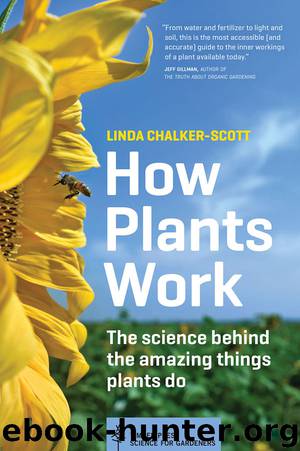How Plants Work by Linda Chalker-Scott

Author:Linda Chalker-Scott
Language: eng
Format: epub, pdf
Publisher: Timber Press
Published: 2015-05-05T16:00:00+00:00
Plant cells contain dissolved substances that keep cellular water from freezing, encouraging ice to form between the cells instead.
How do evergreen leaves combat this frozen doom? You know the answer by now: it’s anthocyanins! Low temperatures cause leaves to accumulate anthocyanins in a wide variety of garden favorites, both evergreen and deciduous, including maples (Acer species), red-twig dogwood (Cornus sericea), smokebush (Cotinus), Euonymus species, English ivy (Hedera helix), Oregon grape (Mahonia repens), apple (Malus domestica), pines (Pinus species), peach (Prunus persica), and sumac (Rhus species). We’ve already seen how anthocyanins help deciduous leaves prepare for their autumnal demise, but evergreen leaves accumulate anthocyanins as a kind of antifreeze. Once accumulated, anthocyanins help red-tinged leaves of Oregon grape, viburnum, and rhododendron hang onto their cellular water better than green leaves of the same plant. Water that’s bound inside the cells is not able to migrate easily into intercellular spaces, so the leaves are able to withstand colder temperatures. They can accumulate so many anthocyanins that their leaves are visibly redder than they were during the summer. When spring returns along with warmer temperatures, winter-reddened leaves regain their usual green color. This doesn’t happen in all evergreen species, but those that do turn red sure brighten up our winter landscapes.
This freeze-avoiding benefit that anthocyanins offer is also useful in those juvenile leaves we talked about earlier. Leaf buds are tough little structures, resistant to hard winter freezes, but once they break dormancy the emerging leaves are susceptible to late spring frosts—even mild ones. Ice forms quickly on top of and inside these tissues, and that’s the end of those leaves. But anthocyanins can lower the freezing point of water, just like adding salt to sidewalks keeps them from freezing. Juvenile anthocyanins allow leaves to survive their youth, much like immunizations help our children avoid fatal diseases and become teenagers. (And we have the pleasures of gardening to help us survive teenagers.)
Download
This site does not store any files on its server. We only index and link to content provided by other sites. Please contact the content providers to delete copyright contents if any and email us, we'll remove relevant links or contents immediately.
| Anatomy | Animals |
| Bacteriology | Biochemistry |
| Bioelectricity | Bioinformatics |
| Biology | Biophysics |
| Biotechnology | Botany |
| Ecology | Genetics |
| Paleontology | Plants |
| Taxonomic Classification | Zoology |
Sapiens: A Brief History of Humankind by Yuval Noah Harari(14311)
The Tidewater Tales by John Barth(12625)
Mastermind: How to Think Like Sherlock Holmes by Maria Konnikova(7274)
Do No Harm Stories of Life, Death and Brain Surgery by Henry Marsh(6904)
The Thirst by Nesbo Jo(6874)
Why We Sleep: Unlocking the Power of Sleep and Dreams by Matthew Walker(6649)
Life 3.0: Being Human in the Age of Artificial Intelligence by Tegmark Max(5506)
Sapiens by Yuval Noah Harari(5320)
The Longevity Diet by Valter Longo(5038)
The Body: A Guide for Occupants by Bill Bryson(5024)
The Rules Do Not Apply by Ariel Levy(4905)
The Immortal Life of Henrietta Lacks by Rebecca Skloot(4546)
Animal Frequency by Melissa Alvarez(4424)
Why We Sleep by Matthew Walker(4392)
The Hacking of the American Mind by Robert H. Lustig(4334)
Yoga Anatomy by Kaminoff Leslie(4331)
All Creatures Great and Small by James Herriot(4266)
Double Down (Diary of a Wimpy Kid Book 11) by Jeff Kinney(4238)
Embedded Programming with Modern C++ Cookbook by Igor Viarheichyk(4135)
